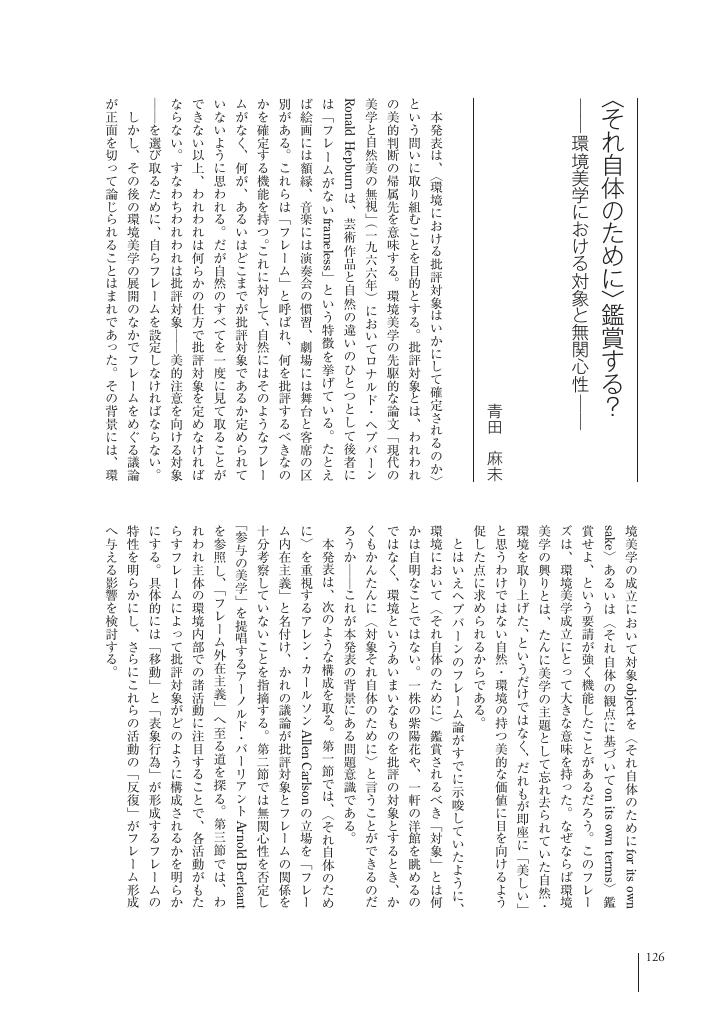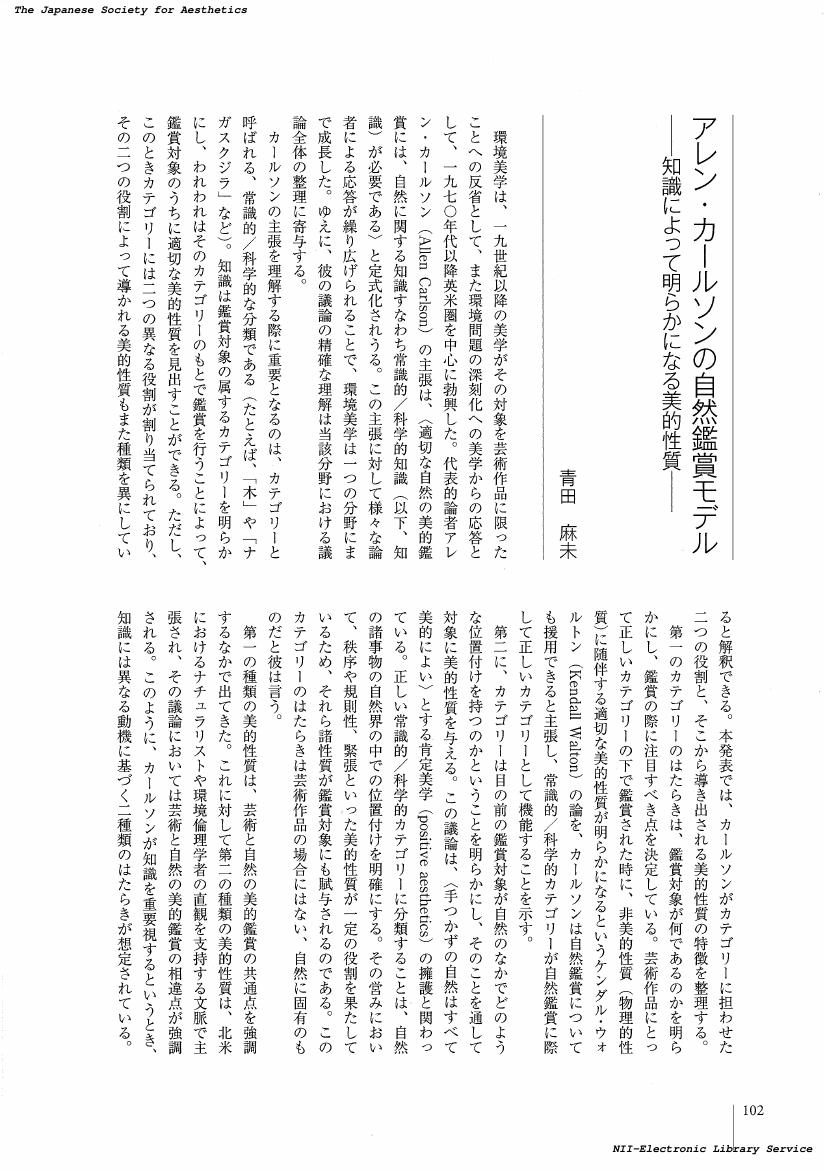本研究では、「態度適合理論/分析」を、感情、自然・環境、生命、文化、ジェンダー、セクシャリティの観点から改良・使用することで、多元的で多様な現代社会に対応した尊厳概念を「社会的地位/身分」ではなく「絶対的価値」として正当化し、従来のモデルを克服する尊厳理解の新たなモデルを築くとともに、尊厳概念のより正確な定義を提案する。これにより、尊厳概念に多元化・多様化・拡張化を強く求める社会の要請に十分に応答可能な概念を「尊厳学」の確立の基盤として提供する。さらに、「生きるに値する/値し ない」の優生学的線引きとして機能することのない尊厳概念を練り上げ、その射程を人間以外のさまざまな存在者にまで拡張する。
- 著者
- 青田 麻未
- 出版者
- 美学会
- 雑誌
- 美学 (ISSN:05200962)
- 巻号頁・発行日
- vol.66, no.1, pp.89-100, 2015
In this paper I will present one interpretation of Allen Carlson's theory for aesthetic appreciation of nature. Carlson claims that we must know commonsense/scientific categories of nature for appropriate aesthetic appreciation of it. There are two intentions behind his statement: one is to make an objective theory for the judgment of nature and the other is to advocate for the assertions of environmentalists on pristine nature. According to these intentions I think Carlson assigns two different roles to those categories, and consequently he assigns two different kinds of aesthetic properties for the same nature through those categories. First, those categories can function to determine the focus of aesthetic appreciation of nature. Here Carlson depends on Kendall Walton's theory of categories of art and applies it to aesthetic appreciation of nature. In this case categories reveal some aesthetic properties that depend on non- aesthetic (physical) properties of nature. Second, categories can function to show the positions of objects in natural order. Through this function categories reveal aesthetic properties that objects can have in relation to natural order. Finally I will point out the difference and similarity of those two aesthetic properties and show the limit of Carlson's view.
3 0 0 0 IR 動物の美的価値 : 擬人化と人間中心主義の関係から
- 著者
- 青田 麻未
- 出版者
- 東京大学大学院人文社会系研究科・文学部美学芸術学研究室
- 雑誌
- 美学藝術学研究 (ISSN:13426095)
- 巻号頁・発行日
- no.37, pp.1-29, 2019-03-22
2 0 0 0 OA 環境の時間変化と鑑賞 参与を伴う活動によるフレームの構築
- 著者
- 青田 麻未
- 出版者
- 美学会
- 雑誌
- 美学 (ISSN:05200962)
- 巻号頁・発行日
- vol.70, no.2, pp.1-12, 2019 (Released:2021-05-08)
I will show how we can frame temporal dimensions of our environments for our appreciation. In contrast to artworks, environments are changing all the time. There is no frame with which to define what is the specific object of appreciation in environments which surround us, and which extend without limit. We have to create our own frames by ourselves. The question is how we frame temporal changes of environments. First, I will classify the changes in two groups: macro- and micro- temporal change. We cannot directly perceive the former, but can with the latter. Although we can perceive micro changes, it is difficult to appreciate them because they are so ordinary for us that we usually do not pay any attention to them. Second, I will introduce Arnold Berleant’s “aesthetics of engagement” to clarify the mechanism of framing these micro changes. Engagement is a kind of aesthetic attitude for appreciating perceptual environmental experiences which consisted of cumulative micro changes. Third, I will elaborate on the role of our activity in framing micro changes. I will distinguish our activities in environments into two levels, and show how aesthetic engagement is related to each level.
- 著者
- 青田 麻未
- 出版者
- 青土社
- 雑誌
- ユリイカ (ISSN:13425641)
- 巻号頁・発行日
- vol.51, no.18, pp.115-123, 2019-11
1 0 0 0 OA 「地域アート」の芸術的価値─環境美学の視点から─
- 著者
- 青田 麻未
- 出版者
- 美学会
- 雑誌
- 美学 (ISSN:05200962)
- 巻号頁・発行日
- vol.72, no.1, pp.25-36, 2021 (Released:2023-03-20)
This paper discusses the artistic value of “community-engaged art project” from the perspective of environmental aesthetics. Community-engaged art project refers to art projects that take place in a specific region for revitalization and other similar purposes. I evaluate the artistic value of it in terms of creating a chain of discovery of the aesthetic value of a place by various subjects. Section 1 examines Vid Simoniti’s “pragmatic view” of the artistic value of socially engaged art (SEA). Section 2 points out two problems that arise when applying the practical view of local art. The first is the ambiguity of community revitalization as a social purpose, and the second is that the view overlooks that art is an act of making something. Section 3 interprets previous research on creative placemaking and site-specificity from the perspective of environmental aesthetics and argues that local art creates a chain of discovery of the aesthetic value of a place at the initial stage of revitalization. Section 4 explains what exactly a chain of discovery of the aesthetic value of a place means, referring to the case of the Oku-noto triennale.
1 0 0 0 OA 居住環境における「親しみ」の美的経験の成立条件
- 著者
- 青田 麻未
- 出版者
- 美学会
- 雑誌
- 美学 (ISSN:05200962)
- 巻号頁・発行日
- vol.70, no.2, pp.114, 2019 (Released:2021-05-08)
1 0 0 0 環境の時間変化と鑑賞:参与を伴う活動によるフレームの構築
- 著者
- 青田 麻未
- 出版者
- 美学会
- 雑誌
- 美学 (ISSN:05200962)
- 巻号頁・発行日
- vol.70, no.2, pp.1-12, 2019
I will show how we can frame temporal dimensions of our environments for our appreciation. In contrast to artworks, environments are changing all the time. There is no frame with which to define what is the specific object of appreciation in environments which surround us, and which extend without limit. We have to create our own frames by ourselves. The question is how we frame temporal changes of environments. First, I will classify the changes in two groups: macro- and micro- temporal change. We cannot directly perceive the former, but can with the latter. Although we can perceive micro changes, it is difficult to appreciate them because they are so ordinary for us that we usually do not pay any attention to them. Second, I will introduce Arnold Berleant's "aesthetics of engagement" to clarify the mechanism of framing these micro changes. Engagement is a kind of aesthetic attitude for appreciating perceptual environmental experiences which consisted of cumulative micro changes. Third, I will elaborate on the role of our activity in framing micro changes. I will distinguish our activities in environments into two levels, and show how aesthetic engagement is related to each level.
1 0 0 0 「地域アート」の芸術的価値 : 環境美学の視点から
- 著者
- 青田 麻未
- 出版者
- 美学会 ; 1950-
- 雑誌
- 美学 = Aesthetics (ISSN:05200962)
- 巻号頁・発行日
- vol.72, no.1, pp.25-36, 2021
1 0 0 0 OA 〈それ自体のために〉鑑賞する? 環境美学における対象と無関心性
- 著者
- 青田 麻未
- 出版者
- 美学会
- 雑誌
- 美学 (ISSN:05200962)
- 巻号頁・発行日
- vol.68, no.2, pp.126, 2017 (Released:2019-01-02)
1 0 0 0 OA アレン・カールソンの自然鑑賞理論における美的性質 : カテゴリーのはたらきに注目して
- 著者
- 青田 麻未
- 出版者
- 美学会
- 雑誌
- 美学 (ISSN:05200962)
- 巻号頁・発行日
- vol.66, no.1, pp.89-100, 2015-06-30 (Released:2017-05-22)
In this paper I will present one interpretation of Allen Carlson's theory for aesthetic appreciation of nature. Carlson claims that we must know commonsense/scientific categories of nature for appropriate aesthetic appreciation of it. There are two intentions behind his statement: one is to make an objective theory for the judgment of nature and the other is to advocate for the assertions of environmentalists on pristine nature. According to these intentions I think Carlson assigns two different roles to those categories, and consequently he assigns two different kinds of aesthetic properties for the same nature through those categories. First, those categories can function to determine the focus of aesthetic appreciation of nature. Here Carlson depends on Kendall Walton's theory of categories of art and applies it to aesthetic appreciation of nature. In this case categories reveal some aesthetic properties that depend on non- aesthetic (physical) properties of nature. Second, categories can function to show the positions of objects in natural order. Through this function categories reveal aesthetic properties that objects can have in relation to natural order. Finally I will point out the difference and similarity of those two aesthetic properties and show the limit of Carlson's view.
- 著者
- 青田 麻未
- 出版者
- 美学会
- 雑誌
- 美学 (ISSN:05200962)
- 巻号頁・発行日
- vol.65, no.2, pp.102, 2014-12-31 (Released:2017-05-22)


